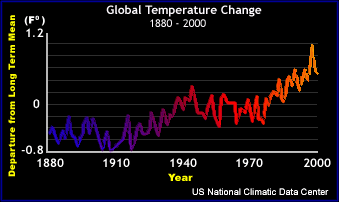| Home › Climate | ||||

 |
||||
In the past 20 years, media reports of climate issues have largely focused on global challenges, such as greenhouse gases or catastrophic storms like hurricanes Hugo, Andrew, and Fran. Beyond the headlines and behind the scenes, however, tens of thousands of economic decisions are made each day with the aid of climatic information. Reliable climate information and data are necessary-directly or indirectly-to achieve sustainable economic advantages in virtually every enterprise in America. What's the Difference Between Weather and Climate? Climate accounts for all past weather events and for future climate predictions. If we assume that climate is not changing rapidly, then high-quality, long-term climate data can tell us the qualitative range of weather events we might expect in the future. Accurate climate data collected over a long period can also provide useful quantitative assessments of the likelihood of various weather conditions in the next several years. Who Uses Climate Information?
 In agriculture and horticulture, the needs for climate information are obvious. The duration of the growing season depends on plant type and air temperature. Both livestock and crops depend on the availability of water, which is usually derived from local or watershed precipitation. Even the time of day when precipitation occurs is important to efficient water use. The heat tolerance of plants and animals determines what climates are favorable for different species. Less obvious dependencies, such as the number of cool days required for apples and peaches to mature properly, are climatic in nature. Architects and structural engineers need to know factors such as wind
loading; snow loads for roofing; precipitation for drainage and lawn The transportation industry is a large consumer of climatic data. Commercial
aviation has been one of the primary forces for standardized and improved
national weather You may not realize that athletics The legal profession is one of the larger segments of the climatic data user community in the United States. Attorneys and insurance companies often use official Federal Government weather records to help settle claims that may have resulted partly or entirely from adverse weather. Conversely, the absence of adverse weather may be used to argue against the validity of a claim. Insurance companies also use climatic data to establish actuarial statistics for determining premiums on policies that include a weather risk. Weather characteristics at a particular time and place have been used to corroborate or refute testimony and to help pinpoint the time and location of an event.

Climate, Science, and Record Keeping Climate is an integral part of the geological and biological history of planet Earth. In this sense, the value of climate records transcends pure economics and adds an aesthetic dimension that cannot be easily quantified. The spirit of this assertion is implicit in the name that the early climatologists gave to periodic summaries of weather statistics: The Decennial Census of the Climate.  Just as the U.S. Constitution mandates a socioeconomic census, the World Meteorological Organization mandates 10-year calculations of Climatic Normals. And like the conventional census, the climate census has immediate and long-term economic applications, as well as scientific and historical value. The National Climatic Data Center (NCDC), headquartered in Asheville, North Carolina, is the official repository for the United States' collection of global weather records. In addition to the varied information and data services provided by the NCDC, research is conducted to meet challenges ranging from assessing global warming to helping local ferry services. |
||||
National Atlas of the United States® and The National Atlas of the United States of America® are registered trademarks of the United States Department of the Interior Help us improve the National Atlas Privacy Statement, Disclaimer, Accessibility, FOIA http://www.nationalatlas.gov/climate.html Last modified: Thursday, 27-Jan-2011 17:24:26 CST |
 |
|